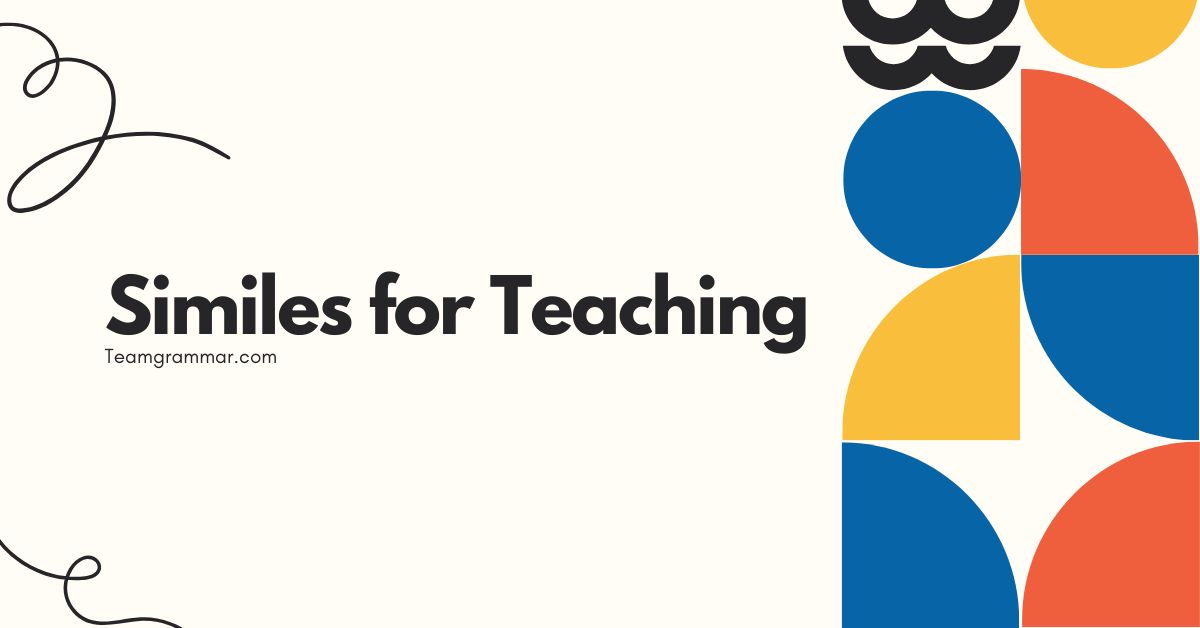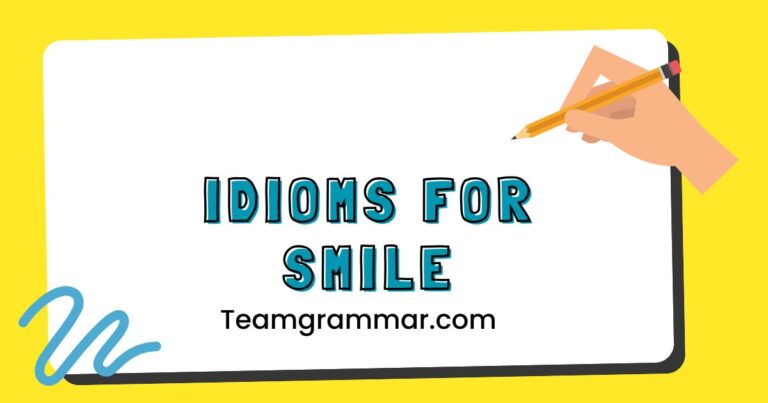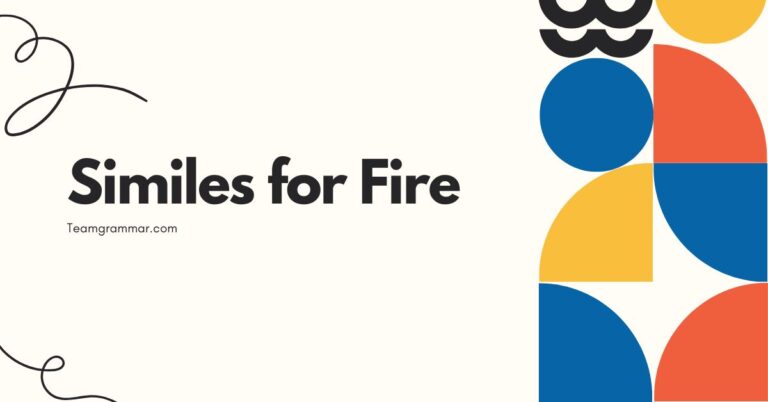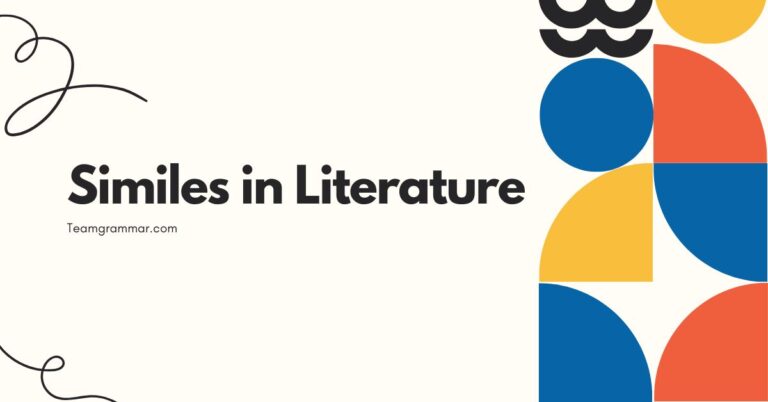45 Similes for Teaching: Mastering Figurative Language for Vivid Descriptions
Similes are a cornerstone of figurative language, enriching our expressions and adding depth to communication. Understanding similes is crucial for both native English speakers and learners alike, as they enhance writing, comprehension, and creative expression.
This article provides a comprehensive guide to similes, covering their definition, structure, types, usage rules, and common mistakes. It’s designed for students, writers, and anyone looking to improve their command of the English language and appreciate the art of comparison.
This guide will help you not only identify similes but also use them effectively to convey meaning and create vivid imagery. Whether you’re preparing for an exam, crafting a compelling narrative, or simply aiming to enhance your vocabulary, this resource will equip you with the knowledge and practice you need to master the art of similes.
Table of Contents
- Definition of Similes
- Structural Breakdown
- Types of Similes
- Examples of Similes
- Usage Rules
- Common Mistakes
- Practice Exercises
- Advanced Topics
- FAQ
- Conclusion
Definition of Similes
A simile is a figure of speech that directly compares two different things using the words “like” or “as.” The purpose of a simile is to create a vivid image or enhance understanding by drawing a parallel between something familiar and something less so. In essence, it’s a tool for making descriptions more engaging and relatable.
Similes fall under the broader category of figurative language, which also includes metaphors, personification, and hyperbole.
The function of a simile is to illuminate a particular quality or characteristic shared by the two things being compared. This comparison helps the reader or listener visualize and comprehend the subject more effectively.
For example, saying “He runslikethe wind” conveys not just the speed of his running but also the effortless and powerful nature of the wind. This form of expression adds color and depth to our language, making it more impactful and memorable than a literal description.
Similes are used extensively in literature, poetry, everyday conversation, and even advertising. They are a versatile tool that can be adapted to a wide range of contexts and purposes.
Whether you’re writing a novel, giving a presentation, or simply trying to make a point in a conversation, similes can help you communicate more effectively and engagingly. The key is to choose comparisons that are both accurate and evocative, creating a strong connection between the two dissimilar things.
Structural Breakdown
The structure of a simile is generally quite straightforward, consisting of three main components: the subject being described, the word “like” or “as,” and the object or concept it is being compared to. Understanding this structure is essential for both identifying and creating effective similes.
Let’s break down each component in detail.
- The Subject: This is the person, place, thing, or idea that is being described. It’s the focus of the comparison. The subject can be concrete (e.g., a tree, a car) or abstract (e.g., love, fear).
- The Connector (“like” or “as”): These are the key words that signal a simile. They explicitly indicate that a comparison is being made. While “like” and “as” are the most common connectors, other words such as “than” or “resembles” can sometimes be used to create simile-like comparisons.
- The Object of Comparison: This is the person, place, thing, or idea that the subject is being compared to. It should share a common characteristic with the subject, allowing for a meaningful and illuminating comparison. The effectiveness of a simile often depends on the appropriateness and familiarity of the object of comparison.
For example, in the simile “Her smile wasasbrightasthe sun,” “her smile” is the subject, “as” is the connector, and “the sun” is the object of comparison. The simile suggests that her smile is radiant and warm, similar to the sun.
Understanding these three components allows you to deconstruct and analyze any simile you encounter, and it also provides a framework for creating your own.
The order of these components can sometimes be varied for stylistic effect, but the fundamental structure remains the same. For instance, you could say “Likea roaring lion, he charged into the room,” which places the object of comparison at the beginning but still maintains the core elements of a simile.
The key is to ensure that the comparison is clear and that the connection between the subject and the object of comparison is easily understood.
Types of Similes
While all similes share the basic structure of comparing two things using “like” or “as,” they can be further categorized based on the nature of the comparison and the intended effect. Here are three common types of similes:
Positive Similes
Positive similes are used to highlight a desirable or admirable quality of the subject. They often draw comparisons to things that are considered beautiful, strong, or virtuous.
These similes aim to create a favorable impression of the subject and evoke positive emotions in the reader or listener.
For instance, “She isasgracefulasa swan” is a positive simile that emphasizes the elegance and beauty of the subject. The comparison to a swan evokes images of smooth, fluid movements and refined poise.
Similarly, “He isasbraveasa lion” highlights the subject’s courage and strength by comparing him to a powerful and fearless animal.
Negative Similes
Negative similes, conversely, are used to highlight an undesirable or unflattering quality of the subject. They often draw comparisons to things that are considered ugly, weak, or unpleasant.
These similes aim to create a negative impression of the subject and evoke negative emotions.
For example, “His temper islikea volcano” is a negative simile that emphasizes the subject’s explosive and destructive anger. The comparison to a volcano evokes images of uncontrolled rage and potential harm.
Similarly, “She isasstubbornasa mule” highlights the subject’s obstinacy and unwillingness to compromise.
Ironic Similes
Ironic similes are used to create a contrast between what is said and what is actually meant. They often involve comparing the subject to something that is seemingly positive but actually has negative connotations in the given context.
These similes can be used for humorous or satirical effect.
For instance, “He’sassharpasa marble” is an ironic simile that suggests the subject is not actually intelligent, despite the common association of “sharp” with intelligence. The comparison to a marble, which is smooth and featureless, implies a lack of mental acuity.
Similarly, “She’sasfriendlyasa rattlesnake” is an ironic simile that suggests the subject is actually dangerous and untrustworthy, despite the appearance of friendliness.
Examples of Similes
To further illustrate the use of similes, here are numerous examples categorized by the aspect they describe. These examples should help you understand how similes can be used to add depth and color to your writing.
Similes Describing Appearance
Similes can be used to vividly describe someone’s or something’s appearance. The following table presents a variety of similes used to portray physical characteristics.
| Simile | Explanation |
|---|---|
| Her hair was like spun gold. | Describes hair that is bright, shiny, and golden in color. |
| His eyes were as blue as the ocean. | Describes eyes that are a deep, vibrant blue, reminiscent of the sea. |
| She was as pale as a ghost. | Describes someone with a very white or colorless complexion. |
| He stood like a giant. | Describes someone who is very tall and imposing. |
| Her skin was as smooth as silk. | Describes skin that is soft and without blemishes. |
| His face was like a roadmap. | Describes a face with many wrinkles or lines, suggesting age and experience. |
| She dressed like a queen. | Describes someone who dresses in a luxurious and regal manner. |
| His teeth were as white as pearls. | Describes teeth that are very white and lustrous. |
| She moved like a shadow. | Describes someone who moves quietly and stealthily. |
| His beard was like a tangled bush. | Describes a beard that is unkempt and overgrown. |
| Her smile was like sunshine. | Describes a smile that is warm, radiant, and cheerful. |
| He was as thin as a rail. | Describes someone who is very slender or underweight. |
| Her voice was like velvet. | Describes a voice that is smooth, soft, and pleasing to the ear. |
| He looked like a drowned rat. | Describes someone who is wet, disheveled, and miserable. |
| She shone like a star. | Describes someone who is radiant, beautiful, and captivating. |
| He was built like a brick house. | Describes someone who is very muscular and sturdy. |
| Her eyes sparkled like diamonds. | Describes eyes that are bright, lively, and full of energy. |
| His hair stood on end like needles. | Describes hair that is stiff, upright, and spiky. |
| She was as fresh as a daisy. | Describes someone who is vibrant, youthful, and full of energy. |
| He was as round as a barrel. | Describes someone who is overweight and has a round body shape. |
| Her skin glowed like moonlight. | Describes skin that is radiant and luminous. |
| He was dressed like a scarecrow. | Describes someone who is wearing old, mismatched, or tattered clothes. |
| She moved like a gazelle. | Describes someone who moves with grace, speed, and agility. |
| His hands were like sandpaper. | Describes hands that are rough and coarse to the touch. |
| She was as delicate as a flower. | Describes someone who is fragile, gentle, and easily harmed. |
Similes Describing Behavior
Similes can also be used to describe someone’s behavior. Here are some examples of similes that illustrate different behavioral traits.
| Simile | Explanation |
|---|---|
| He eats like a horse. | Describes someone who eats a very large amount of food. |
| She works like a beaver. | Describes someone who is very industrious and diligent. |
| He sleeps like a log. | Describes someone who sleeps very soundly and deeply. |
| She sings like an angel. | Describes someone who sings beautifully and melodically. |
| He fought like a tiger. | Describes someone who fights fiercely and aggressively. |
| She gossips like a magpie. | Describes someone who talks a lot, often about trivial matters or other people’s business. |
| He follows like a shadow. | Describes someone who follows closely and persistently. |
| She leads like a general. | Describes someone who leads with authority, confidence, and strategic skill. |
| He argues like a lawyer. | Describes someone who argues skillfully, persuasively, and with attention to detail. |
| She dances like a butterfly. | Describes someone who dances gracefully, lightly, and with fluid movements. |
| He drinks like a fish. | Describes someone who drinks alcohol excessively. |
| She spends money like water. | Describes someone who spends money freely and without much thought. |
| He watches like a hawk. | Describes someone who watches carefully and attentively. |
| She listens like a child. | Describes someone who listens with rapt attention, curiosity, and innocence. |
| He complains like a broken record. | Describes someone who complains repeatedly and monotonously. |
| She plans like an architect. | Describes someone who plans meticulously, strategically, and with attention to detail. |
| He acts like a clown. | Describes someone who behaves in a silly, amusing, or foolish manner. |
| She negotiates like a diplomat. | Describes someone who negotiates skillfully, tactfully, and with a focus on achieving a mutually beneficial outcome. |
| He sulks like a child. | Describes someone who sulks childishly, showing displeasure or resentment in a quiet, passive way. |
| She remembers like an elephant. | Describes someone who has a very good memory. |
| He talks like a machine gun. | Describes someone who talks rapidly and continuously. |
| She worries like a mother hen. | Describes someone who worries excessively and protectively. |
| He works like a dog. | Describes someone who works very hard and tirelessly. |
| She smiles like a Cheshire cat. | Describes someone who smiles broadly and mysteriously. |
| He jumps like a frog. | Describes someone who jumps high or awkwardly. |
Similes Describing Emotions
Emotions can be abstract and difficult to describe. Similes can help convey the intensity and nature of feelings.
Here are some similes related to emotions.
| Simile | Explanation |
|---|---|
| He was as happy as a lark. | Describes someone who is very cheerful and joyful. |
| She was as sad as a willow. | Describes someone who is sorrowful and drooping in spirit. |
| He was as angry as a hornet. | Describes someone who is very irritated and easily provoked. |
| She was as calm as a still pond. | Describes someone who is peaceful, serene, and undisturbed. |
| He was as scared as a rabbit. | Describes someone who is very frightened and likely to flee. |
| She felt like a fish out of water. | Describes someone who feels uncomfortable or out of place in a particular situation. |
| He was as nervous as a long-tailed cat in a room full of rocking chairs. | Describes someone who is extremely anxious and apprehensive. |
| She was as excited as a kid in a candy store. | Describes someone who is thrilled and eager. |
| He felt like a million dollars. | Describes someone who feels wonderful and full of energy. |
| She was as lonely as a cloud. | Describes someone who feels isolated and solitary. |
| He was as jealous as a hawk. | Describes someone who is highly envious and possessive. |
| She was as surprised as a toddler finding a snake in her diaper. | Describes someone who is completely taken aback and astonished. |
| He was as frustrated as a one-armed juggler. | Describes someone who is annoyed and unable to achieve their goal. |
| She felt like she was walking on air. | Describes someone who feels elated and joyful. |
| He was as guilty as sin. | Describes someone who feels extremely remorseful and responsible for wrongdoing. |
| She was as relieved as a prisoner being released. | Describes someone who feels a great sense of freedom and ease after a period of stress or difficulty. |
| He was as confused as a chameleon in a bag of Skittles. | Describes someone who is bewildered and uncertain. |
| She felt like she had been hit by a truck. | Describes someone who feels physically and emotionally exhausted. |
| He was as hopeful as a lottery winner. | Describes someone who is full of optimism and anticipation. |
| She was as disappointed as a kid on Christmas morning who only got socks. | Describes someone who feels let down and sad. |
| He was as determined as a honey badger. | Describes someone who is resolute and persistent. |
| She felt like she was drowning in despair. | Describes someone who is overwhelmed by sadness and hopelessness. |
| He was as optimistic as a groundhog on February 2nd. | Describes someone who is very hopeful and positive. |
| She was as nostalgic as an old photograph. | Describes someone who is sentimental and longing for the past. |
| He was as compassionate as Mother Teresa. | Describes someone who is caring and empathetic. |
Similes Describing Objects
Similes are also used to describe objects, adding detail and imagery to their descriptions. Here are some examples:
| Simile | Explanation |
|---|---|
| The car was like a rocket. | Describes a very fast car. |
| The house was as quiet as a tomb. | Describes a very silent house. |
| The snow was like a blanket. | Describes how snow covers everything softly and completely. |
| The moon was like a silver coin. | Describes the moon’s shape and color. |
| The rain fell like tears. | Describes the gentle and continuous falling of rain. |
| The computer was as slow as molasses. | Describes a very slow computer. |
| The bread was as hard as a rock. | Describes very hard bread. |
| The music was like a lullaby. | Describes soothing and gentle music. |
| The coffee was as black as night. | Describes very dark coffee. |
| The diamond shone like the sun. | Describes a very bright and sparkling diamond. |
| The pillow was as soft as a cloud. | Describes a very soft pillow. |
| The fire crackled like popcorn. | Describes the sound of a fire. |
| The ice was as smooth as glass. | Describes very smooth ice. |
| The road stretched like a ribbon. | Describes a long, winding road. |
| The city was like a jungle. | Describes a chaotic and overgrown city. |
| The book was as heavy as a brick. | Describes a very heavy book. |
| The silence was like a heavy blanket. | Describes a thick and oppressive silence. |
| The fog hung like a shroud. | Describes thick and obscuring fog. |
| The waves crashed like thunder. | Describes the loud and powerful sound of waves. |
| The building towered like a skyscraper. | Describes a very tall building. |
| The knife was as sharp as a razor. | Describes a very sharp knife. |
| The honey was as sweet as sugar. | Describes very sweet honey. |
| The fabric felt like feathers. | Describes very soft fabric. |
| The painting was like a photograph. | Describes a very realistic painting. |
| The shadow stretched like a long arm. | Describes a long and extending shadow. |
Similes Describing Speed
Similes can effectively communicate the speed of actions or objects. Here are some examples of similes that describe speed.
| Simile | Explanation |
|---|---|
| He ran like the wind. | Describes someone who runs very fast. |
| She moved as quick as lightning. | Describes someone who moves extremely fast. |
| The car sped off like a bullet. | Describes a car accelerating very quickly. |
| Time passed like a blink of an eye. | Describes time passing very quickly. |
| News spread like wildfire. | Describes news spreading very rapidly. |
| He ate the cake like a vacuum cleaner. | Describes someone who eats very quickly. |
| She finished the race like a rocket. | Describes someone who finishes a race very fast. |
| The rumor spread as fast as greased lightning. | Describes a rumor spreading extremely quickly. |
| He responded like a shot. | Describes someone who responds immediately. |
| She worked like a whirlwind. | Describes someone who works very quickly and energetically. |
| The project progressed like a snowball rolling downhill. | Describes a project progressing rapidly and gaining momentum. |
| He learned the language like a sponge absorbs water. | Describes someone who learns very quickly and thoroughly. |
| She adapted to the new environment like a chameleon. | Describes someone who adapts very quickly and easily. |
| The information traveled like a current. | Describes information spreading quickly and efficiently. |
| He reacted like a coiled spring. | Describes someone who reacts instantly and powerfully. |
| She grasped the concept like a flash. | Describes someone who understands something very quickly. |
| The idea took off like a rocket. | Describes an idea that becomes popular very quickly. |
| He devoured the book like a hungry wolf. | Describes someone who reads very quickly and eagerly. |
| She escaped like a phantom. | Describes someone who escapes very quickly and stealthily. |
| The data streamed like a torrent. | Describes data flowing very quickly and abundantly. |
| He solved the problem like a computer. | Describes someone who solves a problem very quickly and efficiently. |
| She advanced like a chess master. | Describes someone who moves forward strategically and quickly. |
| The machine processed the information like a well-oiled engine. | Describes a machine processing information quickly and smoothly. |
| He dodged the question like a seasoned politician. | Describes someone who avoids answering a question skillfully and quickly. |
| She responded to the crisis like a firefighter. | Describes someone who reacts quickly and effectively in an emergency. |
Usage Rules
Using similes effectively involves adhering to certain guidelines to ensure clarity, impact, and appropriateness. Here are some key usage rules to keep in mind:
- Ensure Clarity: The comparison should be easily understood by the reader. The connection between the subject and the object of comparison should be clear and logical. Avoid obscure or overly complex comparisons that may confuse the audience.
- Create Vivid Imagery: Choose objects of comparison that evoke strong and specific images in the reader’s mind. The more vivid the image, the more impactful the simile will be. Consider sensory details such as sight, sound, smell, taste, and touch to enhance the imagery.
- Maintain Appropriateness: The comparison should be appropriate to the context and tone of the writing. Avoid similes that are offensive, insensitive, or out of place. Consider the audience and the purpose of the writing when choosing a simile.
- Avoid Clichés: Clichéd similes, such as “as busy as a bee” or “as strong as an ox,” have become overused and lack originality. Strive to create fresh and unique comparisons that will capture the reader’s attention.
- Use Sparingly: While similes can enhance writing, overusing them can make the writing feel forced and unnatural. Use similes judiciously and only when they add significant value to the description.
- Consider Cultural Context: Be mindful of cultural differences that may affect the understanding and interpretation of similes. A comparison that is familiar and meaningful in one culture may be obscure or even offensive in another.
By following these usage rules, you can ensure that your similes are effective, engaging, and appropriate for your audience and purpose. Remember that the goal of a simile is to enhance understanding and create a vivid image, so choose your comparisons carefully and thoughtfully.
Common Mistakes
Even with a good understanding of similes, it’s easy to make mistakes. Here are some common errors to avoid:
| Incorrect | Correct | Explanation |
|---|---|---|
| He is intelligent like an idea. | He is intelligent like a computer. | The object of comparison must be concrete and understandable. |
| She sings as beautiful. | She sings as beautifully as an angel. | The simile must include both “as” and a clear comparison. |
| The car is fast, like. | The car is fast like a rocket. | The simile needs a complete comparison. |
| He runs good like a cheetah. | He runs well like a cheetah. | Use the correct adverb form for the comparison. |
| She is similar to the sun. | She is as bright as the sun. | “Similar to” indicates a general similarity, not a simile. |
| His anger is a volcano. | His anger is like a volcano. | This is a metaphor, not a simile; it needs “like” or “as.” |
| He’s as unique as everyone else. | He’s as unique as a snowflake. | The comparison should highlight a distinctive quality. |
| She’s as tall as. | She’s as tall as a tree. | The comparison needs a complete object. |
| He works hard as a person. | He works hard like a beaver. | The comparison should be specific and descriptive. |
| She dances graceful like a swan. | She dances gracefully like a swan. | Use the correct adverb form to modify the verb. |
Practice Exercises
Test your understanding of similes with these practice exercises. The exercises are divided into three levels of difficulty: identification, completion, and creation.
Simile Identification
Identify the similes in the following sentences.
| Question | Answer |
|---|---|
| 1. The baby slept like a log. | like a log |
| 2. Her eyes were bright and sparkling. | No simile |
| 3. The runner was as swift as a deer. | as swift as a deer |
| 4. The old house stood silently on the hill. | No simile |
| 5. He roared like a lion. | like a lion |
| 6. She was as gentle as a lamb. | as gentle as a lamb |
| 7. The task was difficult and challenging. | No simile |
| 8. The stars twinkled like diamonds in the sky. | like diamonds in the sky |
| 9. His words cut deeper than any knife. | No simile |
| 10. The clouds were like fluffy cotton balls. | like fluffy cotton balls |
Simile Completion
Complete the following sentences by adding an appropriate simile.
| Question | Answer |
|---|---|
| 1. The water was as cold as… | …ice. |
| 2. He ran like… | …the wind. |
| 3. She sang as sweetly as… | …a nightingale. |
| 4. The night was as dark as… | …ink. |
| 5. The children played like… | …puppies. |
| 6. Her smile was as warm as… | …sunshine. |
| 7. The old man was as wise as… | …an owl. |
| 8. The snow fell like… | …feathers. |
| 9. The building stood like… | …a giant. |
| 10. His heart was as heavy as… | …lead. |
Simile Creation
Create your own similes to describe the following subjects.
| Subject | Example Simile |
|---|---|
| 1. A crowded room | Like a can of sardines. |
| 2. A difficult task | As challenging as climbing Mount Everest. |
| 3. A kind person | As gentle as a summer breeze. |
| 4. A loud noise | Like a thunderclap. |
| 5. A bright light | As radiant as a supernova. |
| 6. A fast car | Like a bat out of hell. |
| 7. A quiet forest | As silent as a sleeping cat. |
| 8. A cold day | Like standing in a freezer. |
| 9. A sweet taste | As sugary as candy floss. |
| 10. A soft touch | Like the caress of a feather. |
Advanced Topics
Beyond the basics, there are advanced techniques and considerations that can further enhance your use of similes:
- Extended Similes: These involve developing a single simile over several sentences or even an entire paragraph. This allows for a more detailed and nuanced comparison, creating a richer and more immersive reading experience.
- Subverted Similes: These involve using similes in unexpected or unconventional ways, often to create humor or irony. For example, instead of saying “He was as brave as a lion,” you might say “He was as brave as a kitten facing a vacuum cleaner.”
- Similes in Poetry: Similes are a staple of poetry, used to create vivid imagery, evoke emotions, and enhance the musicality of the verse. When using similes in poetry, pay close attention to rhythm, rhyme, and sound devices such as alliteration and assonance.
- Similes in Different Genres: The use of similes can vary depending on the genre of writing. In fiction, similes can be used to develop characters, create atmosphere, and advance the plot. In non-fiction, similes can be used to explain complex concepts, illustrate abstract ideas, and engage the reader.
FAQ
Conclusion
Mastering similes is an invaluable skill for anyone looking to enhance their writing, comprehension, and creative expression. By understanding the definition, structure, types, usage rules, and common mistakes associated with similes, you can effectively incorporate them into your communication.
Practice identifying, completing, and creating similes to solidify your understanding and develop your ability to use them with confidence and flair. Whether you’re crafting a compelling narrative, giving a presentation, or simply aiming to enrich your vocabulary, the art of similes will undoubtedly elevate your language skills and captivate your audience.







